
Author: Michael Gardella
Scenes of a Latin Quarter, Rent, and Opera
I believe that the musical Rent and the reading Scenes of the Latin quarter both display an artist who embraces his own struggles and surroundings. The apartment that was shown was very basic and run down, housing only the necessities to live. Alongside Mark and Roger’s apartment, the other character’s are in the same boat as them; this being poor finances and health concerns. The HIV and AIDS crisis were touched upon here, but it did not seem to be as prominent in the physical reading. During this time, being openly gay was often looked down upon.
Alongside this, Maureen’s performance seemed rather confusing. The part were she had the crowd moo when she talked about milk did not really make sense. With the reading, I personally found the different plots hard to follow and understand. Despite this, I think that the chapter Mademoiselle Mimi was easier to understand and follow. I found it more enjoyable to read and the emotion throughout the chapter was clear to see.
The Opera was even harder to understand for me. I do believe it is a unique way of presenting something, but I found it difficult to appreciate its uniqueness. However, I think the musical did a very good job showing the emotions of grief and despair, which allowed the audience to connect more deeply with the characters. Overall, I think the musical was the best of the three, because of the way it engaged the audience.
Punk Rock
I found it interesting to hear Rich Stremme’s story. He was very passionate about his work and he was really appreciative of his audience. He also claimed that he would include all people, but he would not allow people who did not include others to attend his shows. He also said that people from other countries came to listen to him. He remarked that Mexican kids came to see his show and invited him to a gas station after to eat together. I also learned a lot about the difficulties of pursuing punk rock. He mentioned that his group would often lose money trying to promote his concerts. This truly showed dedication and love for his work.
I also appreciated the zines and vinyl disks that were presented to us in class. It was easy to tell that a lot of work was put into each piece. These were primarily focused on the punk rock genre. This showed how Stremme was able to integrate business into his musical
I believe it would have been better to speak to him face to face, because this would have been more personal and we would not have been interrupted by the zoom lag. However, it was still a very nice experience and I enjoyed learning about Rich Stremme’s work and life.
Class Graffiti


The Woman Who Gave Birth to Rabbits
When I first read the play, I was filled with mixed emotions. The whole story about a woman giving birth a rabbit was really confusing. I believed that the story was made up, and it was very interesting to find out that the play was based on a true story from many years ago. I was under the impression that the rabbit symbolized something, but I was not sure what this could have been. I was surprised towards the end of the story when the audience found out that Joshua had been too aggressive when engaging with Mary, and especially how she prayed to have rabbits. Aside from the chaotic story, I thought that Thomas’ comments helped lighten the mood. I also liked the part where the doctor began questioning if Joshua was an actual rabbit.
When we went to the Macaulay building, I thought that the actors would just be reading the play to us. They actually had a lot more emotion than I had expected. I was especially taken back when the readers started screaming for their roles. All of the readers enthusiasm when reading the play really kept me engaged. Hearing Thomas’ sarcasm in person also made the script much more enjoyable. I also enjoyed asking the author, Stephen Gracia, questions about what inspired him to write the play. 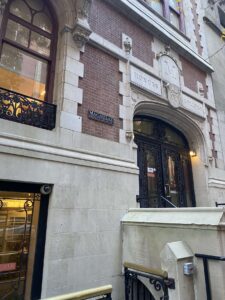
Night at the Museum
When we were first informed about going to the Brooklyn Museum, I did not understand how all of the Macaulay kids would be able to fit in one building. I have never been here before, so I was surprised to see the size of the museum. When we first walked in, I noticed the wooden figures. Their immense size definitely stood out the most.
 We were then taken to the auditorium with all of the Macaulay kids from each campus, where I was able to learn a lot about art and culture. We then learned about the actual definition of a museum and artwork. When we were dismissed from the auditorium, we were free to explore the various exhibits on the different floors. I went straight to the fifth floor, which was notable for its confusing and interesting artworks.
We were then taken to the auditorium with all of the Macaulay kids from each campus, where I was able to learn a lot about art and culture. We then learned about the actual definition of a museum and artwork. When we were dismissed from the auditorium, we were free to explore the various exhibits on the different floors. I went straight to the fifth floor, which was notable for its confusing and interesting artworks.
There were some paintings that stood out that were very detailed and realistic, but the backstory was a little difficult to understand. Despite this, these two pieces shown below are truly art. The amount of time and effort put into each piece is clear.


The last exhibit I visited seemed rather interesting. It featured works of art that are not typically showcased in other museums. The nude art had emphasis on certain body parts that are usually overlooked in other pieces. In addition to this, the human bodies were depicted very differently from how they are normally viewed here. I still can’t quite put my finger on what looked so different in the works seen on the right of the photo below.

After leaving the museum, I was still wondering who the art appealed to and what could be the meaning or backstory behind each piece. In the end, most of the work was very impressive and detailed and I was grateful to have the chance to see it.
Art Lab
When I went to the Art Lab, the street leading right to the entrance was completely flooded, so I had to take a different route. It turned out that every other street after the entrance to the Art Lab was a one-way street going the opposite way, so I had to go down several blocks just to get in through the exit.
When I finally got there, the only class offered was for kindergarteners. Since I was already there, and I didn’t want to just go home without doing anything, I decided to take the class with them. When I walked into the classroom, they were all painting realistic people, but I am still stuck on doing stick figures, so it was embarrassing to see them doing much more advanced pictures. I ended up leaving the class and tried looking for another the same day, but the next class for people my age wasn’t for a few more days, so I would have had to leave and come back a completely different time.
I decided to stay longer and look at the paintings and sculptures that were on display. I also found out that there were many different classes offered. This included classes offered for painting, drawing, sowing, photography, darkroom photography, and stained glass painting. There were many different studios for each class, and many of the works produced there were on display.

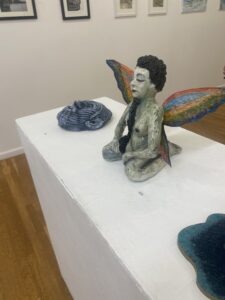
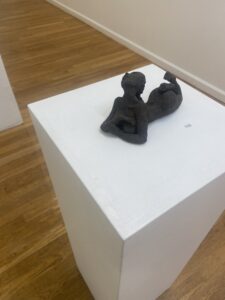

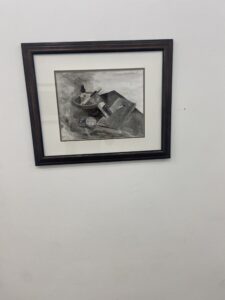


The Counter – Michael Gardella
The Counter is a play about a a waitress and a regular visitor in a local diner of a small town. The unexpectedly become friends and he asks her for an unusual favor which reveals their deepest secrets.
Paul starts off each morning by going to a coffee shop. He would meet Katie and he was determined to become friends with her. He learned that she came from another city, but he assumed she left because of her old boyfriend. It turned out that she had 27 voice mails from him that she kept on her phone, and she wanted to go through each with Paul. As he continued his routine each day, they learned a lot about each other and became friends. He strangely asked Katie to pour a poison he got from the dark web into his drink when he was least expecting it. He said he wanted to go out on his own terms, but he also wanted it to be a surprise.
In addition to this, Katie found out that Paul was once an alcoholic, and Paul found out Katie had a hysterectomy. This was the main reason why Katie left, not just because of her boyfriend. Katie also found out that Paul had an affair with her doctor, Peg Bradley. After going through several of Katie’s boyfriend’s voicemails, a new one was discovered. Katie found out that her old boyfriend came to her town and wanted to see her. This surprised Paul, and then the play ended.
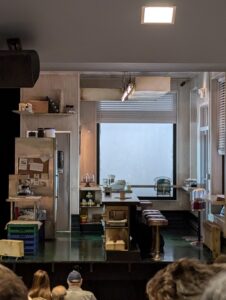
Katie spent the last two years trying to escape her reality. She moved to an isolated town because she got friend zoned by someone she kissed. Paul is different. He wants to have control of his life, which is why he wants to chose the way in which he goes out. He gave Katie the poison because he wants his death to be a surprise. He claims everything was straight forward, like the books he used to read where he could predict what would happen before it actually happens. However, the play ended with Katie deciding to go visit her old friend, which was a complete surprise to him.
I was confused about this ending. It seemed very sudden and I was under the impression that the play would end with Paul being poisoned. It can be inferred that he was poisoned that day, but the audience will never know for sure. Aside from this, I was impressed that the whole play was done by two characters and in the same setting. I also felt like some people in the audience were planted there to laugh at some of the jokes they made throughout the play, even though they weren’t really that funny.
Protest Art – Michael Gardella

The work shown above was made to show how black men were viewed by the rest of society. They are mostly associated with gangs, violence, and guns, which is depicted by the image on the left. In addition to this, the image shows a smaller person behind the gun, which can show that the gang violence is being passed down from generation to generation. In reality, they are just like everyone else. The picture on the right shows a black man reading a book with what could be his son. He is shown to be more loving and welcoming. In both images, the main figure has a heart on their chest. The way the heart was drawn on the left shows violence, while the one on the left depicts a more loving nature. In the end, the artist just wanted to show that a black man is the same as any other man.
The Rubin Art – Michael Gardella
The Rubin Museum features pieces of art from 32 different artists related to Buddhism. This stems from various cultures, including those of Central Asia, India, and the Himalayas. The four works shown below all portray the difference between past and present culture and technology.
The Windhorse
The most notable piece of art at the museum was the hanging cloth in the middle of the staircase. This piece is almost 6 stories tall and is composed solely of a variety of different cloths, differing in color and shape. The location of this work in the stairwell is symbolic of the way people go from Earth to heaven, which is represented by going up the stairs.
At first, I noticed the color scheme and the cloth structure, but I didn’t realize until I got closer that each cloth had writing on it. The writing consisted of various discarded prayers that were put together to form this immense work.
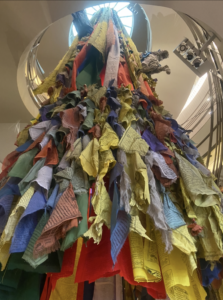
There were horses made of the same fabric protruding on each side for each layer. These five wind horses were adopted by the Buddhists, and they represent fortune and wellbeing, especially in ones’ journey to their afterlife. This part really intrigued me.

Although this piece wasn’t a typical painting or statue, I believe it was one of the best pieces of art I have seen here. Its immense size and detail made this the most significant work in the exhibit.
The Uber Rat
This piece of art showcases past culture integrated with todays technology. The artist, Shushank Shrestha illustrated a divine being, represented by the three eyes, needing modern conveniences. The Uber Rat is supposed to be a mix of a rat and a car, which relates to the hybrid technology in todays society. 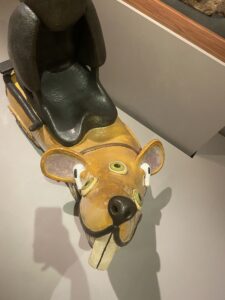
The three eyes on the rat stood out the most, along with the giant teeth. The artist was inspired by the uber drivers in New York City, so he incorporated the air pods. In addition to this, the overall appearance of the rat looks much like a rat you would see in the city.
The Red Strings
When I first walked into the museum, I noticed red strings connected to the railing. On the first floor, there was what I thought was a mannequin in the middle of the red strings posing. When I went downstairs, I noticed she started moving. I was disturbed to see that she was being used as art. 
This exhibit was the only part of the tour that I didn’t appreciate. I found it hard to interpret and connect to.
Monkey Mask
The monkey mask shown below was used in monastic festival dances to teach karma through the Lord of Death. The monkey is said to count out white and black stones, which represents an individual’s good and bad deeds. The peg on the top of the mask was used to help the wearer conceal their head and become one with the monkey. I thought the peg stood out the most, especially because of its large size in relation to the rest of the mask.
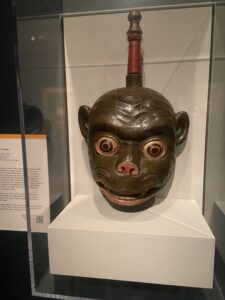
Overall, I believe the art was well crafted and really symbolized the Tibetan culture. I personally couldn’t connect to the art, but I did appreciate the time and detail put in most of the pieces.



